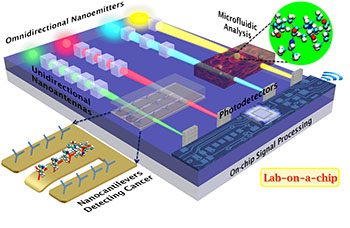
Unidirectional cubic nanoantennas induce directionality to omnidirectional nanoemitters. Credit: D. Sikdar and M. Premaratne / Monash University
As the old saying goes, you can't fit a square peg into a round hole. Passing a beam of light through a square—or cubic—antenna may, however, improve the performance of future “labs on a chip” for biomedical applications.
Researchers at Monash University (Australia) have designed tiny cube-shaped optical antennas for directing visible and near-infrared light through nano-electromechanical systems, or NEMS (J. Appl. Phys., doi:10.1063/1.4907536). The theoretical study indicates that linear chains of cubic dielectric nanoantennas would reduce light loss from heating and scattering better than spherical antennas, and the cube shapes would also be easier to fabricate.
Scientists have already experimented with metallic plasmonic nanostructures to guide light through NEMS, but intrinsic losses limit their usefulness. More recent investigations have focused on the inclusion of large-permittivity dielectrics in these tiny structures, but some recent work indicates that spherical core-and-shell shapes are difficult to manufacture and still exhibit loss due to heating.
Using finite-element-method analysis and other computational tools, the Monash team found that a nanoscale small-permittivity dielectric cube would satisfy the conditions for Kerker's-type scattering, a special case of unidirectional scattering of light. The researchers also examined the effect that changing the interparticle spacing in a row of 200-nm-wide cubes would have on the resulting far-field scattering. Increasing the number of cubes in each row also enhances the directionality and strength of forward scattering.
Based on these calculated parameters for tuning and optimizing these unidirectional nanoantennas, the team will now work on building and testing its proposed nanoantennas at a nearby fabrication facility affiliated with Monash and other Australian universities. “Remaining other components for lab-on-a-chip sensing and detection are also being developed or designed/used in parallel by various research groups,” says lead author Debabrata Sikdar of Monash's department of electrical and computer systems engineering. Possible applications of NEMS include antibody detection, pollution control and other studies of microbiological systems.
